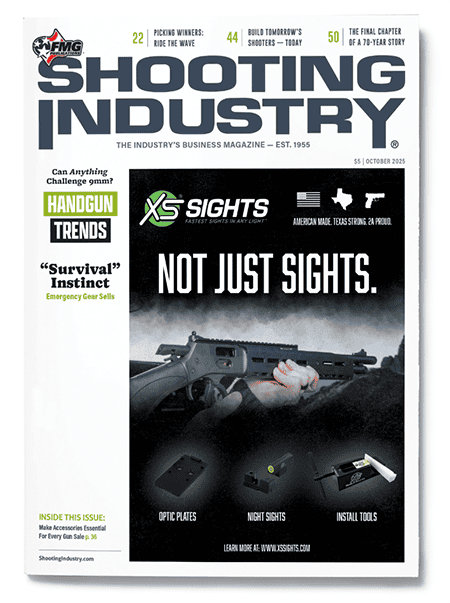After Q3 2025: Where Do We Go From Here?
Earlier this year, a roundtable of dealers reported higher-than-expected firearm sales in the weeks following President Donald Trump’s victory in the 2024 presidential election. At the time, in the Feb. 2025 issue, I highlighted these observations from experienced store owners Henry Parro of Parro’s Gun Shop and Jacquelyn Clark of Bristlecone Shooting, Training & Retail Center in this very column — noting, “there is still more opportunity for business in this market.”
Here in the closing weeks of Q3 2025, things have turned rather sharply. Yes, there are “hot pockets” of growth (namely, suppressors — which will be expounded upon later), but the industry largely finds itself in a perplexing place. Some manufacturers have reacted to the contraction by contracting themselves, with marketing teams across the industry experiencing “organizational restructuring.”
But, as we’ll evaluate, it’s not universal.
Multiple Paths To Growth
Forward-thinking companies like KelTec and Barrett — which are each embarking on strategic efforts to expand capacity and better secure opportunities for future growth — are on the upswing. Others, like Henry and Vudoo Gun Works, are relocating to improve efficiencies.
And, there are acquisitions afoot. Earlier this summer, Ruger acquired Anderson Manufacturing (closing the Anderson brand and integrating the company’s Hebron, Ky., facilities into its manufacturing portfolio). Colt CZ Group purchased Valley Steel Stamp, with Colt CZ Group CEO Radek Musil emphasizing the “strategic rationale” behind this transaction was to achieve “vertical integration in select categories” (e.g., revolver frames, cylinders, spare parts and other firearm components).
Two additional recent acquisitions, also highlighted in this issue’s Industry News section, shed further light into the thinking of growth-oriented brands. Highlighting the benefit of vertical integration, Thompson/Center Arms has added Green Mountain Rifle Barrel Co. to its portfolio. In a press release, T/C Arms stated this integration will help support its ambition to “[explore] new barrel materials, emerging calibers and the latest in barrel-making technology.”
The Kinetic Group (TKG) officially added Fiocchi of America to its lineup of brands. In a corresponding move, HEVI-Shot (a TKG brand) is moving its operation from Sweet Home, Ore., to Ozark, Mo. (where Fiocchi’s U.S. business is located) to form “a center of excellence for shotshell products,” according to TKG Chairman and CEO Jason Vanderbrink.
Whether it’s through expansions, relocations or acquisitions, these methods are employed with one goal in mind: to further sustain long-term profitability. Looking at acquisitions, in particular, I would wager additional consolidation is very likely.
It’s not as dire as “survive or be absorbed,” but until the market is further corrected — and businesses can streamline and adjust accordingly — it’s going to be challenging for smaller, less profitable companies to stay afloat. In today’s market, staying nimble, informed and responsive will be crucial.
NICS Streak Stopped
It had to happen sometime. A streak that began Aug. 2019 — lasting 70 consecutive months — finally ended in July. The July 2025 NSSF-adjusted NICS background checks totaled 978,731, the first time since July 2019 the NSSF-adjusted NICS monthly total did not exceed 1 million. (The July 2019 total was 830,579.) July 2025 represented an 8.1.% drop from July 2024 (1,064,790).
Though the 1-million streak ended, the U.S. firearms industry has been on quite a run. This impressive, near-six-year stretch began in President Trump’s first term, persisted through a global pandemic and social unrest and preserved under an ardent anti-gun presidential administration. To put the magnitude of this streak in context, from Jan. 2000–July 2019 (a period of 19.5 years), the 1 million monthly mark was eclipsed just 67 times.
There was a time when if a month posted 978,731 background checks, especially during summer, it would have been celebrated — which further shows how expectations have changed in recent years. (And, let’s hope we’re at the beginning of another streak: The Aug. 2025 NSSF-adjusted NICS checks totaled 1,091,342. While a decrease of 9.9% compared to the Aug. 2024 NSSF-adjusted NICS figure of 1,210,995, it will hopefully serve as a springboard for Q4 2025.)
Looking back to my Feb. 2025 column once again, something I wrote then is worth repeating now: “We need to get back to showcasing the joy of the shooting sports and competition shooting. Emphasizing the benefit of regulated hunting seasons is another opportunity for our industry to make inroads.”
With the fall hunting season already upon us, make sure you’re connecting with hunters and providing the standout service that will keep them coming back into your store.
Reframing The Conversation Around Suppressors
Suppressors have been a bright spot across the U.S. firearms industry throughout this year. And its poised to shine even brighter when the $200 tax stamp ends Jan. 1, 2026.
Recently, I sat down with Rick Elder, CEO of HUXWRX Safety Co., who shared additional perspective on why suppressors have been so popular.
“We’re seeing a surge now because a suppressor isn’t just a gun accessory anymore — it’s a health and safety device,” he stated. “People care about safety, and departments care about liability. We’ve reached a tipping point where the science, the mission and the market are finally aligned. And yes, I believe this is long-term. Suppressors will be as normal tomorrow as seatbelts are today.”
HUXWRX is focused on innovation, which has been facilitated by the ease of additive manufacturing (otherwise known as … 3D printing). According to Elder, the company can easily run “thousands of prototypes” per year, rather than a couple of iterations, to get exactly what they’re looking for.
This “refusing to accept limitations” mindset led to the development of HUXWRX’s patented Flow-Through suppressors — which redirect expanding gases forward, away from the operator’s face and respiratory system. According to Elder, this technology has been very well received by consumers and professional users.
Elder says the conversation around suppressors needs to be reframed to better educate customers on their benefits.
“We need to stop treating suppressors like novelties or ‘cool gear.’ They’re PPE — personal protective equipment — and we need to teach that like it’s gospel. You wouldn’t send a fireman into a burning building without a mask. Why are we sending people into training or patrols without proper suppression?”
Elder continued, “Most people — civilians and professionals alike — haven’t been made aware that they’re being exposed to a laundry list of toxins such as heavy metals, carbon monoxide, hydrogen cyanide and much more. With understanding comes accountability. We’ve taken it upon ourselves to expose the risks and build solutions that protect the mind, body and mission.”
A mission-first mindset will help dealers expand sales to customers.
“At HUXWRX, we train our dealers the same way we train operators: teach the why first,” Elder said. “We’re not simply selling suppressors. We’re selling peace of mind to a mom whose 19-year-old kid just signed up to serve. We’re selling long-term performance to an officer who wants to retire with his hearing intact. And we’re educating a generation that didn’t know they were fighting a battle they couldn’t see. That’s our mission and we take it very seriously.”
Elder’s passion here is evident, and it got me thinking: Have you evaluated your store’s mission recently? Are you clearly communicating it to your employees? Do your interactions with customers reflect it? Now is a great to reassess your store’s mission, how it sets you apart from the competition and what you can do to further elevate it. Even changes that might seem small or intangible can make a significant impact.
As the saying goes, “How you do anything is how you do everything.”






